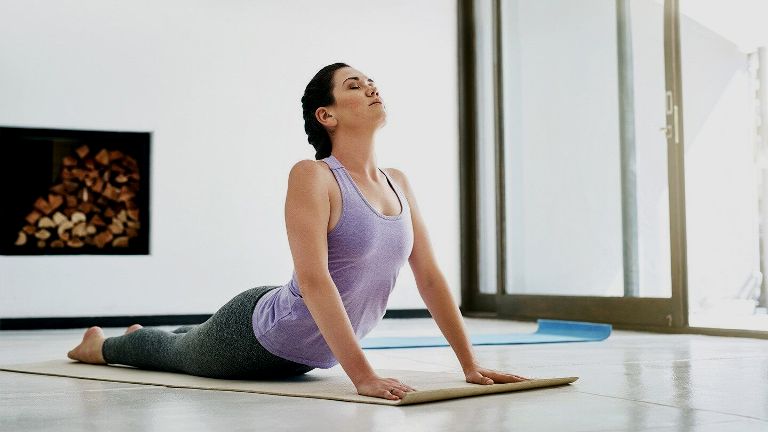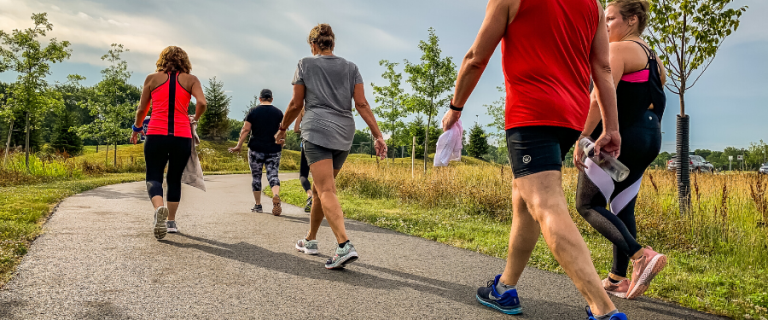
Upward-Facing Dog Pose. COURTESY
Achy back? Give yoga a go. Numerous studies have shown the power of the ancient practice, which emphasizes stretching, strength, and flexibility, to relieve back soreness and improve function.
According to research published in July 2017 in the Annals of Internal Medicine, yoga may even help reduce the need for pain medication. At the start of the three-month study, in which one group was assigned to physical therapy for their back pain, a second to yoga, and a third to reading about pain management strategies, 70 percent of the subjects were taking medication. By the end, however, while the number of people taking medication in the reading group stayed the same, only 50 percent of the yoga and physical therapy subjects were still taking it.
While yoga isn't a good idea if you have severe pain, those with occasional soreness or chronic aches may greatly benefit from certain postures that can help lengthen your spine, stretch and strengthen your muscles, and return your back to its proper alignment, says Jennifer Bayliss, a fitness expert in Williamstown, Massachusetts. Yoga’s focus on balance and steadiness encourages your body to develop defenses against the causes of back pain, which include weak abdominal and pelvic muscles, as well lack of flexibility in the hips. When you strengthen these muscles, you improve your posture, which reduces the load on your back, and thus reduces the aches you feel. In addition, stretching can increase flexibility by increasing blood flow to tight muscles.
Researchers are also starting to discover how yoga’s effects on the brain may contribute to decreased pain. In a study conducted by the National Institutes of Health and published in May 2015 in Frontiers in Human Neuroscience, scientists found that there were significant differences between the brains of those with chronic pain and the brains of regular yoga practitioners. Those with chronic pain had less of the kind of brain tissue in the regions that help us tolerate pain, but those who did yoga had more — which suggests that yoga may be not just physically but neurologically protective.
It's always a good idea to ask your doctor before starting a new fitness regimen, especially if you're prone to pain. Once you get the green light, try these seven soothing poses for back pain. You can do these poses in any order. Gradually increase the intensity by holding them for longer amounts of time. And you might even reap the other health perks of yoga, which include lowered heart rate, lowered blood pressure, improved sleep, and reduced symptoms of depression and anxiety.
Pigeon Pose
Pigeon pose, which can be a little challenging for yoga newbies, stretches hip rotators and flexors. It may not seem like the most obvious position to treat a backache, but tight hips can contribute to lower back pain.
Try it: Start in Downward-Facing Dog with your feet together. Then draw your left knee forward and turn it out to the left so your left leg is bent and near perpendicular to your right one; lower both legs to the ground. You can simply keep your back right leg extended straight behind you, or for an added hamstring stretch — seasoned Pigeon posers, only! — carefully pull your back foot off the ground and in toward your back. Hold the position for 5 to 10 breaths, then switch to the other side, and repeat as needed.
Triangle Pose
Triangle pose is great for strengthening the back and legs and can help lengthen your muscles along the sides of your torso while stretching the muscle fibers along your outer hip (your IT, or iliotibial, band). Try it: Start standing straight with your feet together. Next, lunge your left foot back three to four feet, and point your left foot out at a 45-degree angle. Turn your chest to the side and open up the pose by stretching your right arm toward the ground and the left arm toward the ceiling, keeping both your right and left legs straight. You may not be able to touch the ground with your right arm at first, so don’t overstretch — only bend as far as you can while maintaining a straight back. Hold the position for 5 to 10 breaths, then switch to the other side, and repeat as needed.
Upward-Facing Dog
This pose works to open up your chest, stretch your abdominal muscles, and engage your back. Try it: Start by lying flat on the floor with your palms facedown by the middle of your ribs. While drawing your legs together and pressing the tops of your feet into the floor, use the strength of your back, not your hands, to lift your chest off the floor. Leave your legs extended straight out at first. Hold the position for 5 to 10 breaths, and repeat as needed.












0 Comments